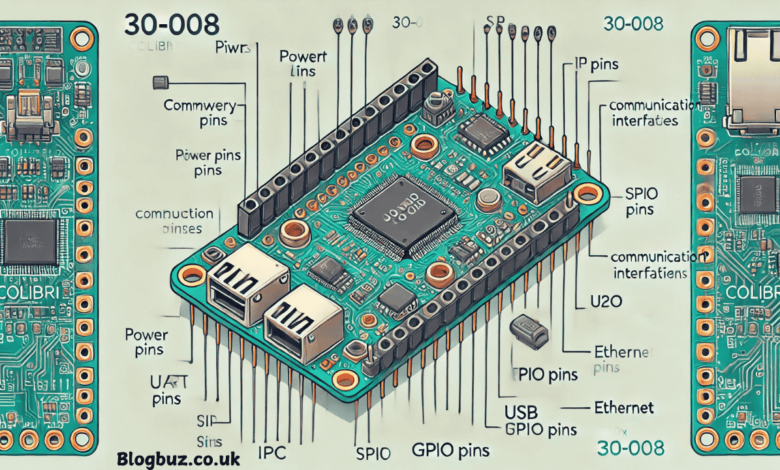Versatility of the 30-008 Colibri Pinout for Embedded Systems

The 30-008 Colibri module, part of Toradex’s System-on-Modules (SoMs) broader family, is a vital component in the embedded systems industry, known for its robust performance and flexibility. This article delves into the specifics of the 30-008 Colibri pinout, explaining its significance, detailing its configuration, and offering insights into its diverse applications across various industrial and technological fields.
Understanding the 30-008 Colibri Pinout
The pinout of a module is a roadmap that details the function of each pin (electrical contacts), which is crucial for connecting and operating the module correctly. The 30-008 Colibri includes power pins, communication interfaces, general-purpose input/output (GPIO) pins, and more, each serving a distinct system design and functionality purpose.
Power Pins: Ensuring Effective Energy Supply
The power pins (VCC and GND) are central to the operation of the 30-008 Colibri module. They ensure the module receives the correct voltage, typically between 3.3V and 5V, which is fundamental for maintaining the stability and reliability of the system. Proper power management is critical, as any deviations can result in damage or malfunction.
Communication Interfaces: Facilitating Data Exchange
The 30-008 Colibri is equipped with several communication protocols:
- UART: Used for serial communication, debugging, and connecting with other controllers or computers.
- I2C: Ideal for connecting low-speed devices like sensors, utilizing just two wires (SDA and SCL) to facilitate communication.
- SPI: Known for high-speed data transfer, using four wires (MOSI, MISO, SCK, CS) to communicate with high-speed devices such as displays or memory chips.
These interfaces ensure that the 30-008 Colibri can handle various tasks, from simple sensor readings to complex data communications.
GPIO Pins: The Backbone of Device Control
GPIO pins on the 30-008 Colibri can be configured as input or output, making them incredibly versatile for various applications. Whether turning on an LED, activating a motor, or reading sensor data, these pins are crucial for interfacing with electronic components and peripherals.
Analog and Digital Capabilities
Some variants of the 30-008 Colibri support analog inputs and outputs in addition to digital functionalities, allowing the module to interact with analog devices. This feature is handy for applications requiring the module to deal with continuous signal variations, such as audio processing or temperature monitoring.
Expanding Capabilities with USB and Ethernet
The inclusion of USB and Ethernet interfaces expands the potential uses of the 30-008 Colibri. USB ports connect a wide range of peripherals, while Ethernet connections enable the module to partake in networked applications, crucial for IoT (Internet of Things) deployments.
Practical Applications of the 30-008 Colibri
The flexibility and robust functionality of the 30-008 Colibri make it suitable for a myriad of applications:
- Industrial Automation: Its ability to control and monitor machinery is a staple in manufacturing environments.
- IoT Devices: The module’s connectivity options are ideal for smart home systems and complex networked sensors.
- Consumer Electronics: Used in devices requiring compact, reliable, and efficient computing power.
- Medical Devices: Its precision and reliability support its use in critical health care applications.
Designing with the 30-008 Colibri
Integrating the 30-008 Colibri into a project requires careful planning and understanding its pinout. Engineers must ensure correct power supply, effective communication setup, and accurate pin connections, typically aided by detailed datasheets and pinout diagrams from Toradex.
Conclusion
The 30-008 Colibri pinout is a cornerstone of modern embedded systems, enabling a wide range of applications due to its versatility and robust functionality. Understanding and utilizing this pinout effectively can lead to successful implementations in countless technology sectors, driving innovation and efficiency. Mastering the 30-008 Colibri’s capabilities is invaluable for anyone working with embedded systems.
FAQs about the 30-008 Colibri Pinout and Its Applications
What is the primary function of the 30-008 Colibri module?
The 30-008 Colibri module is a compact System-on-Module (SoM) designed for embedded systems. It facilitates reliable computing, seamless communication, and versatile interfacing, making it ideal for applications in IoT, industrial automation, and consumer electronics.
What communication interfaces are supported by the 30-008 Colibri module?
The 30-008 Colibri module supports several communication protocols, including UART for serial communication, I2C for low-speed device connectivity, and SPI for high-speed data transfer. These interfaces ensure compatibility with a wide range of peripherals and devices.
How do the GPIO pins enhance the functionality of the 30-008 Colibri module?
The 30-008 Colibri module’s GPIO pins can be configured as input or output, allowing them to control or receive signals from external components. They are commonly used for tasks such as activating motors, reading sensors, or managing LED displays.
What power requirements does the 30-008 Colibri module have?
The 30-008 Colibri module operates on a stable voltage range between 3.3V and 5V. Ensuring proper power supply is critical for maintaining the module’s stability and preventing potential damage or malfunctions.
In which industries is the 30-008 Colibri module commonly used?
The module finds applications across various industries, including industrial automation, IoT devices, consumer electronics, and medical devices. Its flexibility and robust performance suit simple and complex embedded system designs.
You May Also Read: WQR2548: A Deep Dive into Electromechanical Components




